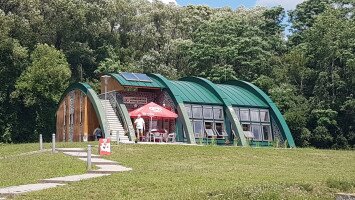2023/1 6. Eagle’s eggs inventory
2023.07.10. 16:00
Um ehrlich zu sein, haben mich Vögel im Allgemeinen noch nie so wirklich interessiert. Aber ich glaube, das liegt daran, da man sie sehr selten aus nächster Nähe zu Gesicht bekommt. Als ich mir die Vogelrettungsstation auf dem Gelände des Direktorats ansehen durfte, wurde mir klar, dass Vögel doch ganz interessant sind, wenn man sich näher mit ihnen beschäftigt!Als ich dann die Gelegenheit bekam, eine Gruppe von Rangern zu begleiten, welche die Adlernester und deren Eierbestand überprüfte, war ich natürlich sofort dabei. Wer möchte es sich schon entgehen lassen einen in freier Wildbahn lebenden Adler aus nächster Nähe zu sehen? Ich jedenfalls nicht.Genauer gesagt handelt es sich bei dieser Art um den Östlichen Kaiseradler (Aquila heliaca) (Für die Interessierten unter euch: https://de.wikipedia.org/wiki/%C3%96stlicher_Kaiseradler). Außerdem gibt es noch eine kleine Population an Seeadlern (Haliaeetus albicilla) in diesem Gebiet.An diesem Tag lag unser Fokus allerdings nur auf den Nestern des Kaiseradlers. Die Aufgabe bestand darin, den Bestand an Eiern in allen Nestern zu überprüfen, zu dokumentieren und anschließend abzuwarten, dass das Weibchen wieder zu ihrem Nest zurückkehrt. Es wurden zwei Gruppen gebildet. Gruppe Nr. 1 hatte die Aufgabe die Eier im Nest zu zählen. Dafür mussten wir (zum Glück) nicht etwa auf den Baum klettern, sondern bedienten uns modernster Technik in Form einer Drohne. Die zweite Gruppe beobachtete aus einer Entfernung von ca. 800 m das Nest per Fernglas und dokumentierte minutengenau, wann das Weibchen das Nest verließ und wann es, nachdem die Drohne wieder weg war, zu ihren Eiern zurückgekehrt war. Das konnte mal nur 15 Minuten dauern, mal mehrere Stunden. Zum Glück war ich in der ersten Gruppe. ;)Im Durchschnitt legen Kaiseradler 1-3 Eier. Bei unseren Nestern waren es meistens drei, also ein ziemlich guter Durchschnitt. Die kommende Kaiseradlergeneration ist somit gesichert. Bis wir die zehn Nester alle abgeklappert hatten, dauerte es eine Weile. Wir fuhren über endlose Felder und durch Niemandsland, wo sich unsere Wege immer wieder mit denen von Fasanen, Feldhasen und Rehen (ich habe noch nie an einem Tag so viele Rehe gesehen) kreuzten. Alles in allem ein sehr interessanter, tierreicher Tag, beendet natürlich mit einem obligatorischem Kaffee.
Tovább olvasom
















